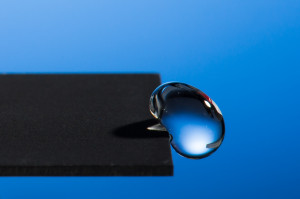
Professor Chunlei Guo has developed a technique that uses lasers to render materials hydrophobic, illustrated in this image of a water droplet bouncing off a treated sample.
Photo: J. Adam Fenster / University of Rochester
New super-hydrophobic metals developed at the University of Rochester could mean big things for solar innovation and sanitation initiatives.
The researchers, led by Professor Chunlei Guo, have developed a technique that uses lasers to render materials extremely water repellant, thus resulting in rust-free metals.
Professor Guo’s research in novel not in the sense that he and his team are creating water resistant materials, instead they are creating a new way to develop these super-hydrophobic materials by taking away reliance on chemical coatings and shifting to laser technology.
This from University of Rochester:
In a paper published today in the Journal of Applied Physics, Guo and his colleague at the University’s Institute of Optics, Anatoliy Vorobyev, describe a powerful and precise laser-patterning technique that creates an intricate pattern of micro- and nanoscale structures to give the metals their new properties. This work builds on earlier research by the team in which they used a similar laser-patterning technique that turned metals black. Guo states that using this technique they can create multifunctional surfaces that are not only super-hydrophobic but also highly-absorbent optically.
“The material is so strongly water-repellent, the water actually gets bounced off. Then it lands on the surface again, gets bounced off again, and then it will just roll off from the surface,” said Guo.
The material is different than the already water resistant Teflon, which needs to be tilted to a nearly 70 degree angle before water slides off – whereas the new hydrophobic metals need only be tilted roughly five degrees.
As the water bounces off these super-hydrophobic surfaces, its self-cleaning aptitude is also demonstrated. As the water rolls off the surface, it takes all the dirt particles and leaves the surface completely dry.
This technology has the potential to be extremely beneficial in places where it is challenging to keep latrines clean.
The next step for this development is to focus on increasing the speed of patterning the surfaces with the laser, as well as studying how to expand to other materials such as semiconductors – or even creating the world of water repellent electronics.
This promising innovation his piqued the interested of the Bill & Melinda Gates Foundation, which has supported their work. Check out the work ECS has done with the Gates Foundation.

